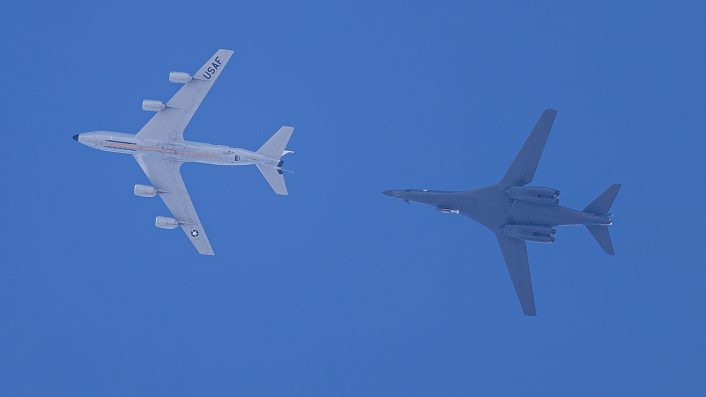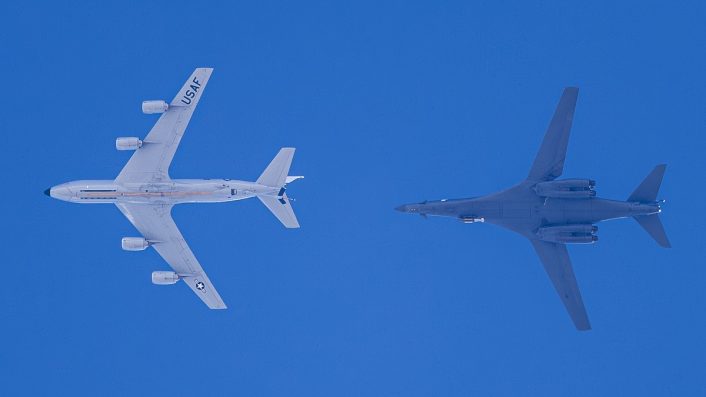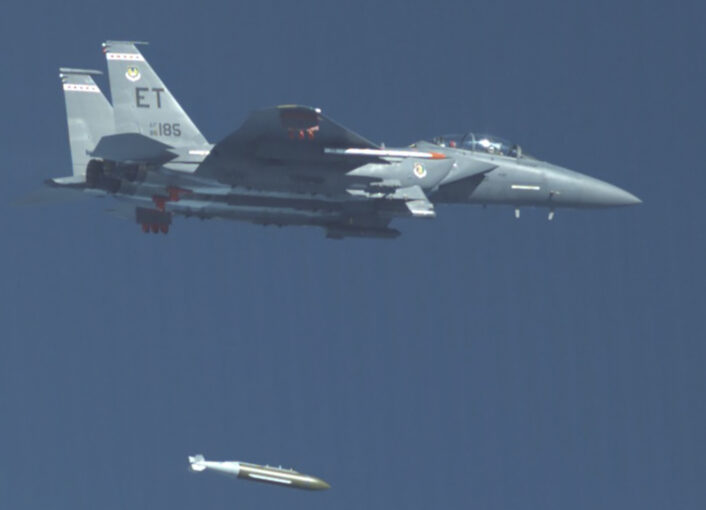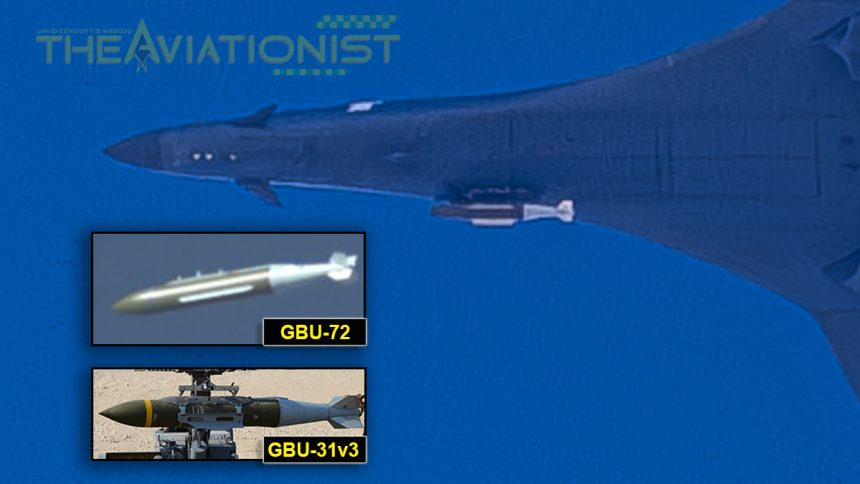Photos show the B-1 carrying a large bomb on the forward right hard point. And it looks like it’s GBU-72/B, the new 5,000 pound “Bunker Buster”.
A U.S. Air Force B-1B Lancer bomber was spotted flying over the Mojave desert with an interesting detail under its fuselage: the BONE (from “B-One”, as the aircraft is unofficially nicknamed) was, in fact, carrying what initially looked like a GBU-31 Joint Direct Attack Munition under the forward right hard point.
The photos were taken and shared with us by photographer Ian Recchio (@lookunderocks on Instagram), who shot them earlier this year and noticed the interesting payload while checking the photo on his screen.

“On March 19th, 2024 I was shooting aircraft and reptiles in the Mojave desert, just north of Owens Lake and heard some chatter on my scanner about “Torch” flying in the area. It is not uncommon to see the Edwards B-1 flying in this area,” said Recchio in an email. “On this day, although I could not confirm definitively it was the Edwards B-1, it appeared while refueling on a KC-135 which is not so common to see, so of course I fired off a few frames. Both aircraft continued to circle the area for about 2 hours, and I took a few more opportunities to captures images.”
We have had the chance to analyse the high-rez version of the photos and the weapon, at first glance, appeared to be the 2,000 lb GBU-31v1/B. However, upon closer inspection, we noticed some differences by looking specifically at the strakes/fins of the JDAM kit. In fact, they appear to be longer than the ones of the GBU-31 (both v1/Mk-84 and v3/BLU-109) and larger, exactly like the ones of the GBU-72.
The GBU-72 Advanced 5K Penetrator is a 5,000-pound bunker-buster bomb tested for the first time in 2021. The test goals were to show the weapon could safely release from the aircraft and validate a modified 2,000-pound joint-direct-attack-munition tail kit’s ability to control and navigate a 5,000-pound weapon.
The GBU-72 was created to address the challenges of targeting deeply buried hardened structures and is suitable for both fighter jets and bombers. The Air Force says its design and anticipated performance were developed using advanced modeling and simulation techniques before the first warhead was ever produced. This method can be applied to all future direct attack weapons. According to James Culliton, the GBU-72 Program Manager, the lethality is expected to be significantly higher than that of older weapons like the GBU-28.
At the time of the test, Culliton highlighted that an advantage of using modeling and simulation in the design process is that early prototypes closely resemble the final production models. “This approach allows us to involve our operational test partners earlier, enabling hands-on participation that validates our design and procedures sooner and incorporates feedback to improve the weapon. The collaboration with the 780th TS and 40th FLTS has been the best I’ve experienced in acquisitions,” he said.
The GBU-72 was first tested on the F-15E but a test on the B-1B would totally make sense and fits the account by Recchio.

That being said, considered the distance we can’t completely rule out the bomb is a different model almost identical, externally, to the GBU-72/B. The fact that the flight took place in daytime, also proves the U.S. Air Force didn’t need to hide the test/sortie with the external carriage.
The B-1B’s external pylons
As Recchio mentioned, from the photos it’s impossible to confirm whether the B-1B was indeed assigned to Edwards Air Force Base; however the situation he captured is similar to the test performed by Edwards’ 419th Flight Test Squadron in 2020 when a B-1B tested the external carriage of the AGM-158 Joint Air-to-Surface Standoff Missile.
In that occasion too, the JASSM was mounted on the forward right hard point, usually used to carry the Sniper ATP (Advanced Targeting Pod). These test flights are demonstrating the bomber’s ability to carry larger-sized weapons both internally and externally.
As explained, the U.S. Air Force successfully completed a series of tests of the 5,000-pound-class bunker-buster bomb on the F-15E in 2021. The fact that they are testing it on the B-1, let alone on the external pylon, makes the photographs even more interesting.

While the U.S. Air Force disclosed the intention to carry externally the JASSM and the info about the ongoing tests, the GBU-72 test was not previously disclosed. However, the test reflects the intention to keep investing on the bomber so it continues to stay relevant in future scenarios until its retirement.
The external hard points were initially thought for the B-1’s nuclear strike mission. However, the bomber mission was reviewed and the type was converted to conventional only weapons with a shift decided in 1994 and a physical conversion that took place between 2007 and 2011, with the Strategic Arms Reduction Treaty (START).
The current expanded carriage demo will make the external hard points and moveable bulkhead available again for delivering conventional weapons so that the B-1 will remain complaint with the New START Treaty. The proposed increase in capacity of means that two B-1s will be able to carry as many weapons as three bombers can carry now.
Arsenal Plane
Originally designed as a low-level penetrating bomber for delivering nuclear weapons deep into Soviet territory, the B-1 Lancer has since shifted focus. Stripped of its nuclear mission, the bomber has seen limited use and, at times, has been repurposed for costly close air support missions in Afghanistan.
The Air Force is on the brink of transforming the B-1 bomber into an Arsenal Plane, capable of striking land targets as well as enemy ships with a barrage of anti-ship and land-attack missiles. Plans are underway to equip the aircraft with up to 36 cruise missiles, significantly enhancing its firepower to levels comparable to those of an aircraft carrier.
The initiative to maximize the B-1’s missile-carrying capacity traces back to the Arsenal Plane concept. This concept, aimed to maximize the use of large aircraft by loading them with a multitude of missiles, has also brought to the development of Rapid Dragon, for palletized missile delivery.
Thanks again to Ian Recchio for allowing us to use the photos and make sure to follow him on Instagram for more!









